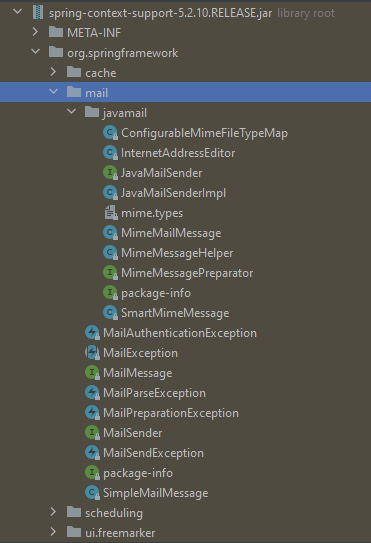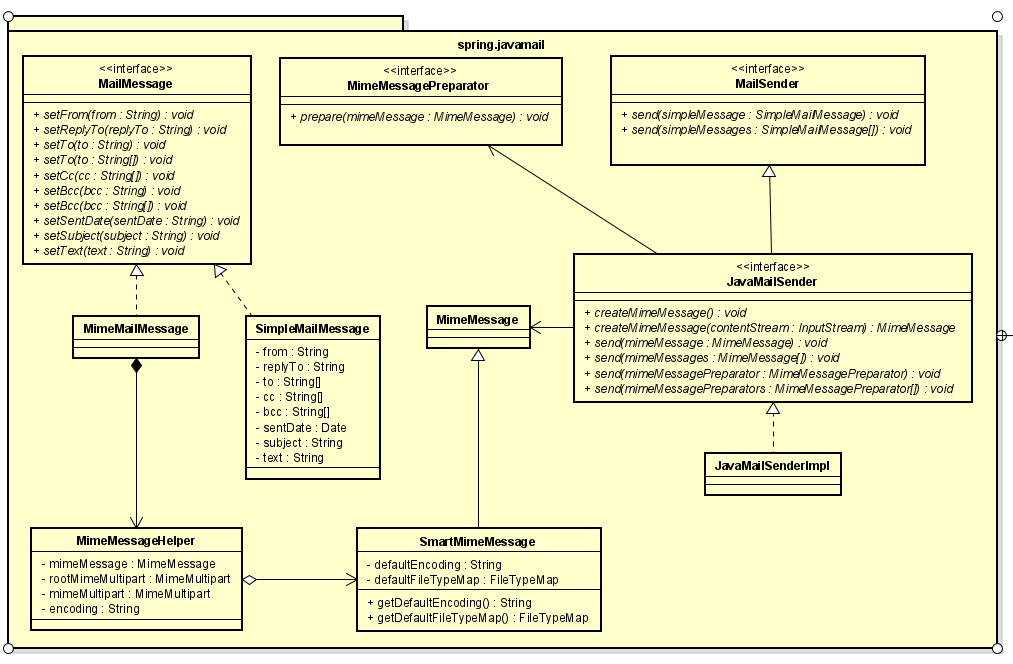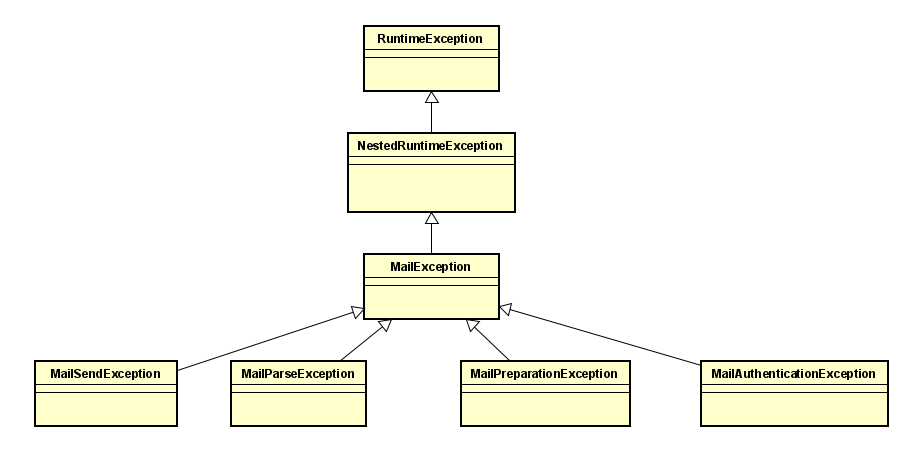Table of contents
How Spring Mail works
-
Some classes that Spring Mail uses

Belows are packages that Spring Mail classes belong to:
- org.springframework.mail
- org.springframework.mail.javamail
-
Class diagram of Spring Mail

The meaning of each class of Spring Mail:
- MailMessage interface - defines actions that will interact with some parts in a mail such as cc, bcc, the receiver, the content of a mail.
-
SimpleMailMessage class and MimeMailMessage class - the derived classes from MailMessage interface.
-
MailSender interface - defines the basic actions for sending mail with the input is SimpleMailMessage.
-
JavaMailSender interface - that supports MimeMessage.
-
JavaMailSenderImpl class - the implementation of JavaMailSender interface that supports both MimeMessage and SimpleMailMessage.
-
MimeMessagePreparator interface - the callback interface for the preparation of JavaMail MIME message.
- MimeMessageHelper class - the helper class for creating a MimeMessage instance. It supports the attachment file and tet content in an HTML layout.
-
Class diagram of Exception in Spring Mail

So, from an above image, we can easily find that MailException is the parent exception class for other exceptions such as MailSendException, MailParseException, MailPreparationException, MailAuthenticationException.
Some steps in using Spring Mail
Belows are some basic steps that we need to configure to run Spring Mail:
-
Fill in some suitable dependencies
<dependency> <groupId>org.springframework.boot</groupId> <artifactId>spring-boot-starter-web</artifactId> </dependency> <dependency> <groupId>org.springframework.boot</groupId> <artifactId>spring-boot-starter</artifactId> </dependency> <dependency> <groupId>org.springframework.boot</groupId> <artifactId>spring-boot-starter-mail</artifactId> </dependency> <dependency> <groupId>org.thymeleaf</groupId> <artifactId>thymeleaf-spring5</artifactId> </dependency> <dependency> <groupId>nz.net.ultraq.thymeleaf</groupId> <artifactId>thymeleaf-layout-dialect</artifactId> </dependency> -
Create an implementation of MailSender interface
In order to send email successfully, we will take a role as sender. So, we need to configure all information of a sender such as email address, username, password, host that can be gmail, yahoo, …, port, protocol, and something else.
-
First way, take advantage of Spring, we will only configure above information into application.properties file.
Belows are some files that Spring accepts:
Key Description spring.mail.host SMTP server host. For example: smtp.gmail.com spring.mail.port SMTP server port spring.mail.username Login user of the SMTP server spring.mail.password Login password of the SMTP server spring.mail.protocol Protocol used by the SMTP server. By default, it is smtp spring.mail.properties.* Additional JavaMail Session properties spring.mail.test-connection Whether to test that the mail server is available on startup To configure more information for JavaMail Session properties, we will know about its properties:
Key Description mail.smtp.connectiontimeout Socket connection timeout value in milliseconds. This timeout is implemented by java.net.Socket. Default is infinite timeout. mail.smtp.timeout Socket read timeout value in milliseconds. This timeout is implemented by java.net.Socket. Default is infinite timeout. mail.smtp.writetimeout Socket write timeout value in milliseconds. This timeout is implemented by using a java.util.concurrent.ScheduledExecutorService per connection that schedules a thread to close the socket if the timeout expires. Thus, the overhead of using this timeout is one thread per connection. Default is infinite timeout. For example:
spring.mail.default-encoding=UTF-8 spring.mail.host=smtp.gmail.com spring.mail.username=username@gmail.com spring.mail.password=password spring.mail.port=587 spring.mail.protocol=smtp spring.mail.test-connection=false spring.mail.properties.mail.smtp.auth=true spring.mail.properties.mail.smtp.connectiontimeout=5000 spring.mail.properties.mail.smtp.timeout=3000 spring.mail.properties.mail.smtp.writetimeout=5000 # TLS, port 587 - current setting spring.mail.properties.mail.smtp.starttls.enable=true # SSL, port 465 spring.mail.properties.maili.smtp.socketFactory.port=465 spring.mail.properties.mail.smtp.socketFactory.class=java.net.ssl.SSLSocketFactoryAfter configuring all information of sender, at startup time, Spring will read about spring.mail.* properties, and automatically creating JavaMailSender for us. Our work is that using @Autowired annotation to get the JavaMailSender bean in our service class.
-
Second way, based on the properties of java mail, we will use them to configure programmatically.
@Configuration public class EmailConfig { @Bean public JavaMailSender javaMailSender() { JavaMailSenderImpl mailSender = new JavaMailSenderImpl(); mailSender.setHost("smtp.gmail.com"); mailSender.setPort(587); mailSender.setUsername("username.gmail.com"); mailSender.setPassword("password"); Properties props = mailSender.getJavaMailProperties(); props.put("mail.transport.protocol", "smtp"); props.put("mail.smtp.auth", "true"); props.put("mail.smtp.starttls.enable", "true"); props.put("mail.debug", "true"); return mailSender; } }
-
-
Configuration about template engine for sending email
In this case, we use thymeleaf to decorator our email form.
@Configuration public class ThymleafConfig { @Bean public SpringTemplateEngine springTemplateEngine() { SpringTemplateEngine templateEngine = new SpringTemplateEngine(); templateEngine.addTemplateResolver(htmlTemplateResolver()); templateEngine.setTemplateEngineMessageSource(emailMessageSource()); return templateEngine; } @Bean public ResourceBundleMessageSource emailMessageSource() { ResourceBundleMessageSource messageSource = new ResourceBundleMessageSource(); messageSource.setBasename("mail/MailMessages"); return messageSource; } @Bean public SpringResourceTemplateResolver htmlTemplateResolver(){ SpringResourceTemplateResolver emailTemplateResolver = new SpringResourceTemplateResolver(); emailTemplateResolver.setPrefix("classpath:/templates/"); emailTemplateResolver.setSuffix(".html"); emailTemplateResolver.setTemplateMode(TemplateMode.HTML); emailTemplateResolver.setCharacterEncoding(StandardCharsets.UTF_8.name()); emailTemplateResolver.setCacheable(false); return emailTemplateResolver; } }In this step, we also need to define the content of mail in html layout. It need to be defined in java/main/resource folder.
-
Building MimeMessage and sending it
We utilize MimeMessageHelper class to apply some advanced functionalities such as attaching files, use HTML layout in text content.
@Data @AllArgsConstructor @NoArgsConstructor public class Mail { private String from; private String to; private String subject; private String content; private Map<String, Object> model; } @Service public class EmailService { private static final String EMAIL_TEMPLATE = "email-template"; @Autowired private JavaMailSender mailSender; @Autowired private SpringTemplateEngine templateEngine; public void sendMessage(Mail mail) throws MessagingException { this.emailSender.send(this.buildMimeMessage(mail)); } private MimeMessage buildMimeMessage(Mail mail) throws MessagingException { MimeMessage message = this.emailSender.createMimeMessage(); MimeMessageHelper helper = new MimeMessageHelper(message, MimeMessageHelper.MULTIPART_MODE_MIXED_RELATED, StandardCharsets.UTF_8.name()); helper.setTo(mail.getTo()); helper.setText(this.getHtmlContent(mail), true); helper.setSubject(mail.getSubject()); helper.setFrom(mail.getFrom()); return message; } private String getHtmlContent(Mail mail) { Context context = new Context(); context.setVariables(mail.getModel()); String html = this.templateEngine.process(EMAIL_TEMPLATE, context); return html; } }Currently, we are using the email-template.html file that is laid in java/main/resource folder.
Some problems when running Spring Mail
-
Username and password are not accepted
When we are encountering with this error message, we need to access to our account’s Less secure app access.
In local environment, we want to test, so turn on this feature.
-
Do not display value of each variable in thymeleaf page
Supposed that we are define an element with:
<h1>Hello, ${name}</h1>It cann’t display the name variable. So, we can use th:text element that is supported by Thymeleaf.
<h1 th:text="'Hello, ' + ${name}"></h1>
Wrapping up
-
Understanding some command steps to send email
-
Create a JavaMailSender instance that have a responsibility to send email.
-
Create a MimeMessage instance that contain all information about a real email.
-
Create a content layout with HTML.
-
-
Understanding about classes that use in Spring Mail.
Refer:
https://docs.spring.io/spring-framework/docs/4.0.x/spring-framework-reference/html/mail.html
https://www.baeldung.com/spring-email
https://memorynotfound.com/spring-security-forgot-password-send-email-reset-password/
https://memorynotfound.com/spring-mail-sending-email-thymeleaf-html-template-example/
https://memorynotfound.com/spring-mail-sending-email-freemarker-html-template-example/
https://memorynotfound.com/spring-mail-sending-email-inline-attachment-example/
https://memorynotfound.com/spring-mail-sending-email-attachment-configuration-example/
https://memorynotfound.com/spring-mail-sending-simplemailmessage-javamailsender-example/
http://blog.michalszalkowski.com/java/spring-boot-send-html-email/
https://memorynotfound.com/adding-static-resources-css-javascript-images-thymeleaf/
https://www.developer.com/java/other/working-with-javamail-and-the-spring-mail-apis.html
Configuration for proxy